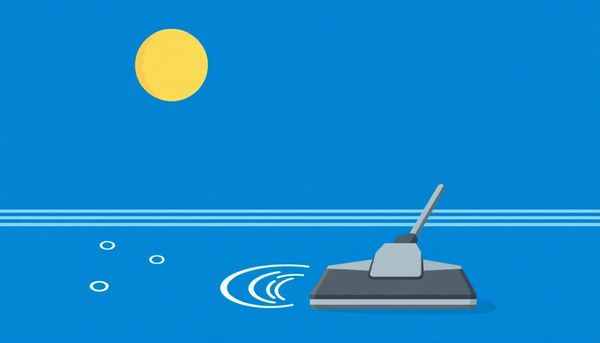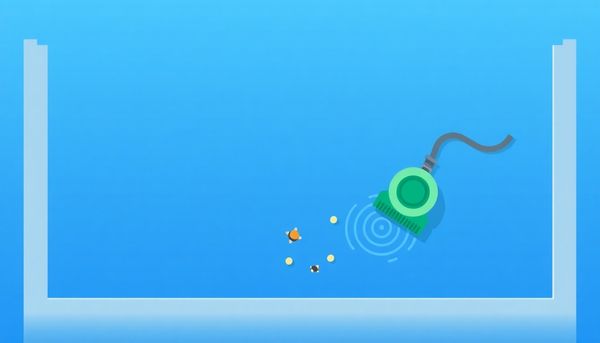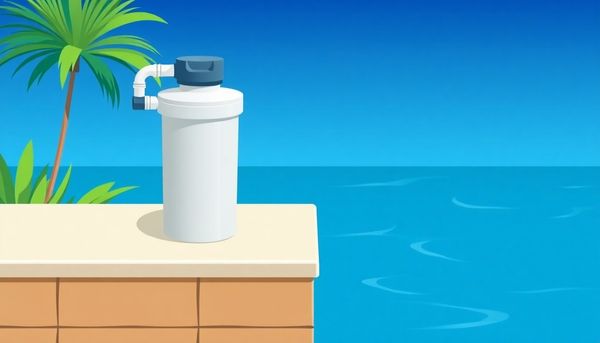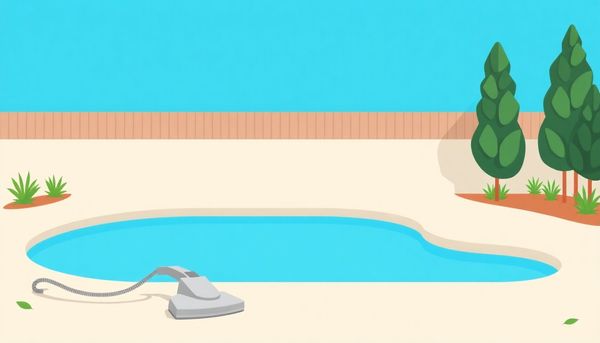Efficient Pool Vacuuming: Master Techniques for Crystal Clear Water
September 13th, 2024
September 13th, 2024
Tending to a pool can often feel like a never-ending chore. One moment, the water is crystal clear and inviting; the next, it's taken on a murky hue sprinkled with leaves and debris. I remember staring at my own backyard oasis one summer afternoon, wishing for a magic button that would instantly restore its pristine condition. Instead, I discovered the art of efficient cleaning. Vacuuming a pool doesn't need to be an all-day affair. With the right approach, it can become a quick and satisfying routine.
Understanding your pool's unique demands is essential. Different shapes and sizes mean different vacuuming strategies. My friend Sarah, for instance, has a kidney-shaped pool that collects debris in awkward corners. She found that directing the flow of water with strategic brushing beforehand made vacuuming noticeably quicker. On the other hand, my rectangular pool tends to gather leaves along the edges, so a systematic approach from the center outwards works wonders.
Having the right tools makes a world of difference. Aligning yourself with a reliable vacuum head, a sturdy hose, and a telescopic pole can speed up the cleaning process significantly. Investing in a quality setup not only saves time but also extends the life of your equipment. Remember, efficiency is all about preparation and adapting techniques to suit your pool's personality. As we explore different tactics together, you'll soon have your pool sparkling in no time, ready for that spontaneous swim or weekend gathering.

Every pool owner has likely faced the challenge of debris swirling at the bottom of their oasis, eagerly waiting to be conquered. Efficiency is key in tackling this task, and adopting a strategic approach can transform hours of work into a swift and satisfying routine. Begin by selecting the right day and time, preferably when the sun is bright and the pool surface is calm. This will ensure better visibility and make the process smoother.
Preparation is your best friend here. Before even touching your vacuum, ensure your pool's chemistry is balanced. A well-maintained chemical balance aids the filtration system in capturing finer particles, reducing the workload on you when vacuuming. Make sure the skimmer and filter are clean and ready to handle the influx of dirt without losing suction.
When setting up the vacuum, consider using a weighted head with a triangle design, as it can glide effortlessly across corners, leaving no space untouched. The telescopic pole should be adjusted to your height, allowing you to reach the pool's depths without straining. If your vacuum hose tends to float, submerge it gradually, letting water fill it to drive out any air bubbles, which can disrupt the suction.
Now, for the technique: slower strokes win the race. Long, deliberate motions ensure that debris is captured effectively without being stirred up. Overlap your paths slightly to guarantee no area is missed. This careful method saves you from having to repeat the process, saving both time and energy.
Using these tips, you'll be back to enjoying your pool in record time, with the satisfaction of a job well done.
Grabbing a manual pool vacuum might seem a little old-fashioned in the age of robotic cleaners, but mastering this technique is akin to having a trusty tool in your arsenal for those stubborn pool cleaning dilemmas. When facing cloudy water or algae, a manual vacuum is your best ally, cutting through the grime with precision.
Begin by ensuring your pump and filter are operating smoothly. Secure the vacuum head to the telescopic pole, and fasten the hose to it. If the hose tends to slip, a simple clamp will do wonders. The weighted vacuum head is key—it hugs the pool floor as you work, making sure nothing gets left behind. Submerge the setup, resting the vacuum head on the pool's bottom, and press the other hose end against a return jet to purge air from the line until bubbles cease to appear.
Whether you’re dealing with algae or murky pool corners, maintaining focused suction is crucial. Place the skim vac plate over the hose end and into the skimmer, forming a tight seal. If you skip the vacuum plate, just insert the hose directly into the skimmer inlet. This setup lets you glide the vacuum across the pool floor with long, deliberate strokes, ensuring each pass slightly overlaps the previous. This method helps avoid stirring up debris, which can otherwise cloud your progress.
Keep a watchful eye on the pressure gauge, and pause to backwash if necessary. A stuck vac head is easily freed by momentarily turning off the pump. With a bit of practice, the technique becomes second nature, providing a quick and thorough clean, readying your pool for the next splash-filled afternoon.
Maintaining pristine pool water isn't just about elbow grease; it's about making your equipment work smarter, not harder. When it comes to vacuuming your pool swiftly, optimizing your filter and pump performance is crucial. Consider this: a well-functioning pump and filter system acts as the heart of your pool, circulating and cleaning water effectively. Ensuring these components operate at their best can significantly reduce the time you spend vacuuming.
Start by assessing your filter type. Whether you're dealing with a diatomaceous earth (D.E.), sand, or cartridge filter, regular maintenance is a must. High pressure on a D.E. or sand filter signals it's time to backwash. For cartridge filters, ensure the cartridges are scrubbed clean. A neglected filter can struggle to trap debris, making your vacuuming efforts less effective.
Next, synchronize your vacuuming session with optimal pump efficiency. Regularly check the pump strainer basket for debris build-up, as it can hinder water flow. A clean strainer ensures the pump maintains consistent suction, crucial for effective vacuuming. Additionally, adjust your filter valve settings based on your pool's condition. For heavy debris or algae, use the "Waste" setting to bypass the filter, preventing clogs and allowing for more efficient suction.
By keeping these components in top shape, you're not just cleaning your pool—you're enhancing the overall health and lifespan of your system, reducing the frequency of those time-consuming cleaning sessions.
When it comes to pool maintenance, selecting the right cleaning equipment can make all the difference. It’s not just about efficiency, but ensuring you’re well-prepared for any pool condition, whether it’s a pristine weekly touch-up or a post-storm disaster. The right tools save time and effort, turning what could be a daunting task into a seamless routine.
For starters, every pool owner should have a reliable manual vacuum. While automatic pool cleaners, like robotic or pressure-side cleaners, offer convenience, they often fall short when dealing with cloudy water or stubborn algae. Picture this: you’re preparing for a weekend pool party, and a surprise algae bloom appears overnight. A manual vacuum can target these problems directly, ensuring your water is party-ready in no time.
In addition to a manual vacuum, a sturdy telescopic pole and a high-quality vacuum head are essential. The weighted triangle vacuum head, for instance, stays grounded, making it easier to clean those pesky corners. For those hard-to-reach spots, a leaf net or brush on the telescopic pole can handle the job.
Don’t forget about the vacuum hose. A properly fitted hose, ideally with a hose clamp, prevents it from slipping during use. This ensures continuous suction and a thorough clean. These tools together form the backbone of effective pool maintenance, allowing you to address any cleaning challenge efficiently. With the right gear in your arsenal, pool cleaning becomes less of a chore and more of a breeze.
There’s a certain satisfaction in mastering the art of manual vacuuming, where technique meets persistence. You might wonder why bother when automatic tools offer ease, yet knowing the ins and outs of manual vacuuming equips you to handle situations those gadgets cannot—such as tackling stubborn algae or murky water.
The journey begins with your trusty vacuum head, a telescopic pole, and a hose. Connect the vacuum head to the pole, and affix the hose securely. Should the hose prove slippery, a hose clamp becomes your new best friend. Submerge the assembly into the pool, allowing the vac head to rest on the pool floor. To purge the hose of air, press its open end against a return jet until bubbles cease.
Next, ensure that the vacuum inlet is the only open line to your pump; this focus prevents debris from slipping past your efforts. For those tricky pool corners and steps, employ the weighted triangle vacuum head—it offers precision and stability. Attach the skim vac plate if you prefer to leave the skimmer basket intact while cleaning, or skip the plate and insert the hose directly into the skimmer inlet for robust suction.
Patience is your ally. Begin at the shallow end, using long, methodical strokes to navigate towards the deep end, ensuring slight overlaps to capture every piece of debris. If your pool’s water becomes cloudy, let it settle and resume vacuuming. Monitor your filter’s pressure gauge; if it spikes, pause and backwash the filter.
As you master these techniques, manual vacuuming transforms from a chore into a skillful exercise, ensuring your pool remains a sparkling oasis for endless enjoyment.
Connecting your vacuum properly to the pool system is the foundation of efficient cleaning. Start by gathering your essentials: the vacuum head, a telescopic pole, and a vacuum hose. Secure the vacuum head to the open end of the pole, ensuring a firm connection. Attach one end of the hose to the vacuum head, using a hose clamp if the fit seems too slippery. At this point, everything should already begin to feel like a well-oiled machine coming together.
With the vacuum head and hose submerged, direct the free end of the hose towards the pool's return jet. This clever trick purges air from the hose, allowing water to fill it completely. You'll notice air bubbles rising, a sure sign that the air is being expelled. Once these bubbles disappear, the hose is primed for action.
Next, focus on the skimmer. If you have a skim vac plate, attach it to the hose end that was flushed with water, then swiftly cover the opening with your hand. Bring it over to the skimmer and secure it on top of the basket, ensuring a tight seal to maintain suction. Without the plate, remove the skimmer basket, block the hose end manually, and insert it directly into the skimmer’s suction port.
Proper setup is half the battle. When done correctly, your vacuum transforms into an efficient debris-churning machine, letting you glide through cleaning with ease and precision. Avoid shortcuts, and you'll find that even this mundane task can become a gratifying ritual, paving the way for crystal-clear waters.
Getting your pool sparkling clean involves more than just elbow grease; it's about using your filter settings wisely. The type of filter you have—whether it's a sand, D.E., or cartridge filter—determines your approach. For those days when your pool resembles a pond more than a pristine oasis, the "Waste" setting is your secret weapon. This bypasses the filter entirely, whisking away the muck without overburdening your system. It's especially handy when dealing with cloudy water or algae that a regular filter can't handle fast enough.
Consider this: a friend of mine once attempted to clean his pool using the "Filter" setting while tackling an algae bloom. The result? A clogged filter and a whole lot of frustration. By switching to "Waste," he not only avoided the hassle of constant backwashing but also sped up the cleaning process. Keep in mind, however, using the "Waste" setting will lower your pool's water level. A garden hose can be employed to replenish water levels, ensuring you don't end up with an empty pool.
For regular maintenance, the "Filter" setting suffices, allowing water to circulate and catch fine debris. Remember, a well-timed backwash can help maintain efficiency, ensuring your filter doesn’t become a bottleneck. By mastering your filter settings, you transform what could be a tedious task into a streamlined operation, giving you more time to enjoy your pool rather than labor over it.
Grabbing the vacuum and tackling your pool may not sound exhilarating, but executing efficient vacuum strokes can transform the task into a satisfying ritual. Start by positioning yourself comfortably at the pool’s edge, where you have a clear view of the entire floor. This isn’t just about getting the job done; it’s about doing it right the first time.
Remember those lazy weekends when your sole aim was to glide seamlessly on a paddleboard? Vacuuming your pool can mirror that rhythm. Begin at the shallow end and patiently guide the vacuum towards the deeper sections. Each stroke should be deliberate and steady; think of it as drawing long lines in the sand. Allow the weight of the vacuum head to do most of the work for you—pushing too hard might disrupt the settled debris, clouding the water.
Envision the pool floor as a giant jigsaw puzzle where each piece must fit perfectly. Overlapping your vacuum strokes ensures you don’t leave any spots untouched. Alternating directions can be particularly effective: first horizontal, then vertical, creating an intersection of clean paths.
If the suction feels too strong or the vacuum head seems to resist, pause and adjust your approach. A brief halt allows for a reset, ensuring the suction is just right without straining your equipment. By maintaining a mindful pace and rhythm, you’ll finish with a pristine pool floor ready for those spontaneous swims or poolside gatherings.

Understanding the intricate dance between a pool filter and a vacuum can transform your cleaning routine from a dreaded chore into a smooth operation. Let's delve into the nuances of optimizing your pool-filter settings for maximum efficiency.
Start by assessing your filter type—be it a D.E., sand, or cartridge filter. A high-pressure reading on D.E. or sand filters signals it's time for a backwash. Cartridge filters, on the other hand, demand a quick rinse to ensure they’re spotless and ready to work. By maintaining your filter, you're setting the stage for a seamless vacuum session.
For those grappling with algae or murky waters, switching the filter valve to the “Waste” setting becomes crucial. This clever adjustment allows for direct removal of debris without clogging your filter. It’s akin to opening a secret trapdoor for unwanted particles, leaving your filter unscathed. Remember to top off with fresh water while vacuuming to keep the pool level steady.
In my own pool-cleaning adventures, balancing filter settings was a game-changer. Initially, I neglected this vital step, leading to constant clogs and inefficient cleaning. Once I embraced the nuances of filter management, vacuuming became not only quicker but incredibly satisfying. The pool transformed from a swampy mess to a crystal-clear oasis, ready for a refreshing swim. Adapting your filter settings might seem subtle, but it holds the key to saving time while achieving a sparkling pool.
Mastering the art of manual vacuuming is an essential skill for any pool owner. While automatic cleaners lend a helping hand for routine maintenance, tackling cloudy water or a surprise algae bloom requires a more hands-on approach. Starting with the right setup is crucial. Before diving in, make sure your pool pump and filter are humming at optimal levels. A high pressure might indicate a need for backwashing if you're using a D.E. or sand filter, while a cartridge filter should be cleaned and ready.
The equipment setup is straightforward, yet vital. Connect the vacuum head to your telescopic pole and secure one end of the hose to it. If the hose is slippery, a hose clamp can be a small hero. Submerge the vac head and pole in the pool, ensuring the head rests on the bottom. Use a return jet to push water through the hose, driving out any air. With air bubbles rising from the head, you’ll know the air is out when they cease.
Creating that all-important suction involves attaching a skimmer plate to the hose end, ensuring a tight seal in the skimmer. Once suction is established, begin vacuuming from the shallow to the deep end with deliberate, overlapping strokes. If debris stirs up, patience is your ally; let it settle before continuing. Keep an eye on the pressure gauge, and if needed, pause to backwash the filter. With these techniques, manual vacuuming can be a satisfying and efficient chore, leaving your pool sparkling and swim-ready.
Adjusting filter settings is akin to fine-tuning a musical instrument; it ensures your pool cleaning task becomes a symphony rather than a cacophony. Before you start vacuuming, it's crucial to understand your filter's capabilities and choose the right setting to maximize efficiency. If your pool's clarity resembles a murky pond due to algae or a recent storm, take advantage of the "Waste" setting. This setting bypasses the filter, sending water directly out, which prevents clogging and removes debris efficiently. Remember, this will lower your pool's water level, so keep a garden hose handy to refill as needed.
For pools requiring a lighter touch, the "Filter" setting allows for routine cleaning without drastic water loss. This setting is optimal when your pool is moderately dirty, allowing the filter to trap debris gradually. However, if your pool is heavily laden with dirt or fine sediment escapes through the filter, the "Waste" setting remains your best ally.
Paying heed to the pressure gauge on your filter is vital. High pressure indicates a need to backwash or clean cartridges, ensuring your system doesn't overwork itself and break down. Just like a chef knows when to stir or leave a pot to simmer, knowing when to adjust these settings will save you time and maintain your equipment's longevity. This careful balancing act allows you to tackle the task with precision and ease.
Automatic pool cleaners can be your best ally when it comes to keeping your swimming pool pristine with minimal fuss. Picture the relief of sipping a cool drink poolside, while the cleaner works its magic. The trick lies in maximizing their potential, ensuring they complement rather than replace traditional cleaning methods.
To start, choose the right type of cleaner for your pool. Robotic cleaners, though pricier, offer unparalleled convenience. They operate independently of your pool’s pump and filter system, have built-in brushes, and are perfect for those who prefer a hands-off approach. Pressure-side cleaners, on the other hand, harness your pool’s pump power to sweep the pool floor and walls effectively, collecting debris in an attached bag. They’re a great option if your pool often collects larger debris like leaves.
Remember, while automatic cleaners excel at regular maintenance, they aren’t a substitute for manual vacuums when dealing with finer particles like algae or when your water turns cloudy. A robust manual cleaning session once or twice a season can tackle these problems head-on.
Lastly, regular maintenance of the automatic cleaner itself is crucial. Empty the filter bags frequently and check for any wear and tear on the moving parts to keep them running smoothly. By integrating these cleaners into your pool care routine, you can enjoy more swims and less scrubbing.

Maintaining a pool can sometimes feel like an endless task, but introducing some smart strategies can transform this daunting duty into a breeze. With manual vacuuming as a cornerstone of your pool upkeep arsenal, it's crucial to streamline the process to maximize efficiency. Begin by organizing your tools and equipment so everything is at arm's length when needed. No more running around the garage searching for that elusive hose clamp.
Consider setting a maintenance schedule that aligns with your lifestyle. Maybe Saturday mornings work best, allowing you to tackle the job with a fresh mind and clear skies. Regularity not only keeps your pool pristine but also transforms the task into a routine, lessening the mental load.
Next, a tidy workspace is your ally. Keep your cleaning gear in a dedicated spot near the pool to save precious minutes before you start. Also, ensure that your equipment is in top-notch condition—check hoses for cracks and verify that the vacuum head is free from obstructions. Efficient swimming pool maintenance often starts with the simple act of preparation.
Finally, integrate technology where possible. Utilize apps or digital reminders to prompt you about maintenance check-ins. This digital aid acts as a gentle nudge to keep you on track, ensuring your pool is always ready for that spontaneous afternoon swim. By adopting these methods, pool maintenance becomes less about drudgery and more about ensuring effortless enjoyment under the sun.
The art of manual pool vacuuming might seem daunting at first, but mastering it can transform a tedious task into a satisfying ritual. Imagine stepping into your backyard, armed with your trusty telescopic pole and vacuum head, poised to reclaim the pristine clarity of your pool. While automatic cleaners do offer a hands-off solution, they often miss the mark when dealing with stubborn algae or murky waters. Here, manual vacuuming earns its stripes.
Start by assembling your gear: connect the vacuum head to the telescopic pole, ensuring the hose fits snugly. A hose clamp can be a lifesaver for slippery attachments. As you lower the vac head into the pool, use a return jet to expel all air from the hose, a process marked by the delightful sight of rising air bubbles. Without this step, you risk inadequate suction, and with it, the glory of a clean pool could slip away.
When maneuvering the vac head, patience is your ally. Begin at the shallow end, and with deliberate, overlapping strokes, glide towards the deep end. This method keeps debris from becoming stirred up and clouding your progress. On occasion, if the water appears cloudy after a session, allow it time to settle before commencing again. Remember, consistent monitoring of your filter's pressure is crucial; if it spikes, a brief backwash might be necessary.
Breaking the vacuum’s hold when it becomes stuck is as simple as a quick pump shutdown. Specialists know that maintaining a gentle hand and a steady pace will see you through to a sparkling finish. With practice, you'll find that manual vacuuming not only saves money but also brings a sense of achievement with each crystal-clear result.
Tuning your pool filter settings is an art that can transform tedious vacuuming into a streamlined process. Begin by evaluating your pool's current condition. Is the water clear with minor debris, or are you grappling with a stubborn cloudiness or algae infestation? Knowing what you’re up against will inform the filter settings you’ll need.
For routine cleaning when your pool is relatively clean, setting the filter to “Filter” mode will suffice. This allows the system to circulate and capture minor debris effectively. However, when dealing with murky waters or heavy debris, switch to the “Waste” setting, bypassing the filter entirely to expel the contaminants directly out of the pool. This is particularly useful if you’re facing a fine silt or algae issue, as it prevents these particles from clogging the filter and recirculating.
While vacuuming on “Waste”, pay attention to the water level. The pool will lose water quickly, so keep a garden hose handy to top off the pool as needed. This strategy not only maintains the water level but also introduces fresh water, enhancing the overall cleaning process.
Remember, optimizing your filter settings isn't just about choosing the right mode; it’s about understanding your pool’s unique needs and responding accordingly. With this approach, you’ll not only save time but also keep your pool in pristine condition, allowing you more moments to enjoy a refreshing swim rather than battling with maintenance.
The sun is high, the pool beckons, but there’s a chore that stands between you and a refreshing dip: the pool vacuuming. Enter the automatic pool cleaner—your new best friend. Think of this gadget as a pool-cleaning robot, tirelessly working its way around the water while you sip lemonade in the shade. These devices are designed to make pool maintenance as effortless as possible. By simply plugging it in and placing it in the pool, the cleaner takes over, skimming the bottom and filtering debris into an internal bag. Once it’s full, empty it, and the cycle begins anew.
Among the top contenders in the world of automatic pool cleaners is the robotic variety, known for its efficiency and thoroughness. A robotic cleaner like the Dolphin Nautilus CC Plus is adept at scrubbing, sweeping, and vacuuming, covering every inch with its intelligent navigation system. For those who prefer pressure-side options, the Polaris Vac-Sweep 360 is a stellar choice. It harnesses the water pressure from your pool's return line, allowing it to scour floors and walls with precision.
Remember the last time you manually vacuumed every nook and cranny of your pool? With these automatic cleaners, that memory can fade into the past. Embrace the technology and reclaim your leisure time. Just let the cleaner do its thing while you dive into relaxation.

Every pool enthusiast knows that having a sparkling clean oasis requires more than just a splash of chlorine. It's about mastering the art of vacuuming with precision and strategy. First, familiarize yourself with your pool's unique layout. Whether it’s an elegant inground or a practical above-ground pool, understanding its nooks and crannies will guide your vacuuming path.
Begin by setting up your manual vacuum, a crucial tool that even the most sophisticated automatic cleaners can't replace when tackling algae or murky water. Secure the vacuum head to the telescopic pole, ensuring the hose is firmly attached. A simple trick I learned? Use a hose clamp to prevent any slippage—especially handy on those humid days when everything seems to be slipping through your fingers.
Position your vacuum near a return jet to fill the hose with water, eliminating air bubbles that could sabotage suction. This step might take a little patience, but the reduction in frustration is worth it. Keep an eye on the pressure gauge as you sweep across the pool floor in long, deliberate strokes. Overlap slightly to ensure no debris is overlooked. If your vacuum gets stuck, a quick pump switch-off can release it without hassle.
Remember, effective vacuuming is a balance of skill and care, ensuring each session is productive. And when the sun is high and poolside relaxation calls, you'll be satisfied knowing your pool is ready for a refreshing swim.
When it comes to tackling your pool’s debris by hand, mastering manual vacuuming techniques can transform this task from a chore to a streamlined process. Instead of relying solely on automatic cleaners, which might not effectively handle algae or cloudy water, a manual approach allows for precision and adaptability.
Begin by ensuring your equipment is in tip-top shape. Attach the vacuum head to the telescopic pole, securing the hose tightly with a clamp if necessary. This step is crucial to prevent the hose from slipping off mid-task. Opt for a weighted vacuum head; it stays grounded at the pool floor, providing stability as you maneuver through the water.
Once your setup is in the pool, eliminate air pockets in the hose by holding it against a return jet until air bubbles disappear. This ensures maximum suction efficiency. If you're utilizing a skim vac plate, attach it to the hose end and secure it over the skimmer basket. This step maintains suction while keeping debris contained.
As you begin vacuuming, start from the shallow end and work towards the deep end. For circular pools, methodically move from one side to the other. Employ long, overlapping strokes to prevent debris from being stirred up unnecessarily. Should the water cloud over during the process, patience is key; let it settle before continuing.
Be mindful of the filter pressure, too. A spike may indicate it’s time for a break to backwash the system. With these techniques, manual vacuuming becomes an efficient way to maintain your pool's sparkle, leaving you more time to enjoy its refreshing embrace.

This article provided insights into maintaining your pool. Start your pool care journey today!
Want to become a pool maintenance expert? Our free Pool School course covers everything you need to know about pool care. From basic maintenance to advanced troubleshooting, you'll learn how to:
Join over 10,000 pool owners who have already transformed their pool care routine. Get started with our free Pool School course today!